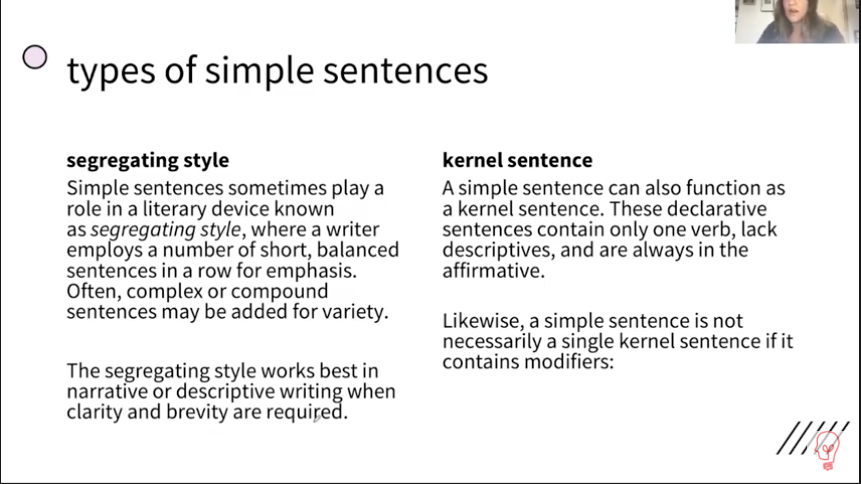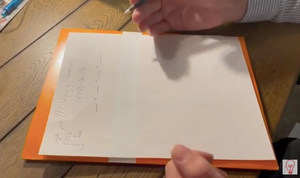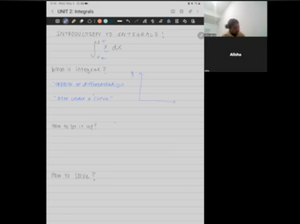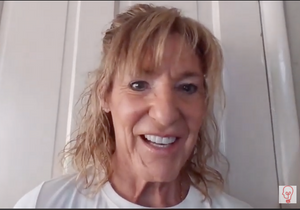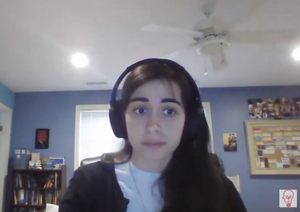Hello, and welcome to tutoring with Kyle. Today we are going to do a lesson on the types of sentences in the English language. We're gonna only focus on two types of sentences today. But there are more than two and as we move forward with our lessons, we'll progress on what we learn, and hopefully, this will help your writing and reading and just overall knowledge of the English language. All right. I'm going to share my screen with you so that we can start the presentation.
We're gonna talk about simple sentences first, and then we're gonna move on to compound sentences.
The simple sentences only have, this is important one independent clause, and I'm gonna highlight that. We'll come back to that definition, though a simple sentence doesn't contain any subordinating clauses, which we'll talk about at a later date.
So you don't need to worry about that right now. It isn't always short. And I think that's important to remind. Remember here that just because it is simple, it doesn't mean that it's going to be short, but a simple sentence can contain modifiers so it can contain adjectives and lots of different words.
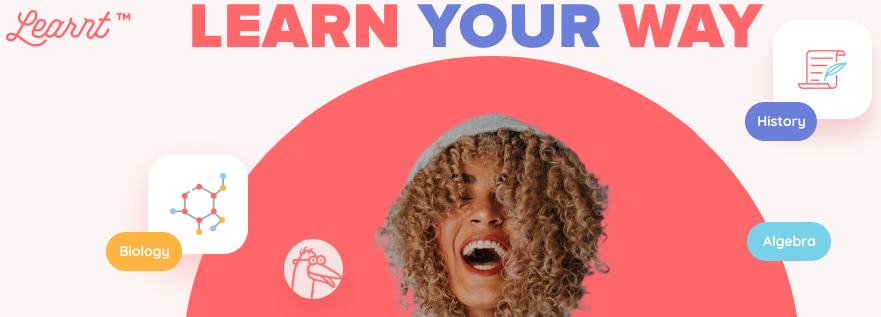
But in its form, it is going to be simple because it only has this one independent clause as we highlighted earlier. So an independent clause, you might be wondering what that is.
It is a part of a sentence a group of words, a clause, and its independent. So it's kind of exactly what you might think. When we think of the word independent it's on its own, it does not depend on anything else to make sense. So, it makes sense on its own.
It's independent, it's free if you will. So here's an example of a simple sentence with an independent clause. I purchased a tour guide and a travel journal at the bookstore. Now I like this sentence in particular because this shows that this isn't a super short sentence. As we talked about earlier. Simple, not necessarily meaning short, but it is simple in the fact that it has a subject I and a verb purchased.
Now we purchased a couple of things. I purchased a tour guide and a travel journal, and it was at the bookstore, but we only have one subject and one verb that we're working with here.
So let's move forward and talk about this a little more in-depth. So at its most basic form, kind of like we just looked at the simple sentence, contains a subject, and then it contains a verb.
So that's very important to remember here. Now the simple sentence can contain adjectives. It can contain adverbs. It can even contain a compound subject, which we will go over at a later date.
But the trick is to look for if there are multiple independent clauses and if they're joined together, that's gonna be a different type of sentence. That's gonna be a compound sentence, but this is what we're talking about here, a simple sentence has only one single subject-verb relationship.
So again, let's go back to our example here. I purchased a tour guide and a travel journal at the bookstore. So we just have that one, subject-verb relationship. And then we have a couple of things here but those are not affected by this just one subject-verb relationship. All right.
Let's look at a couple of sentences. So it's okay to mess up here. This is what this is for. But we're gonna look for these subjects and the verb and each sentence so that we can kind of decipher how these simple sentences are formatted.
At this point in the lesson, I would have the student leader and I would have them tell me if they can work on the same, bored as me, or just, if we were working together in person, I would have them underline the subject and then circle the verbs.
So again, I hear am running, you know, we have Kelsey loves potatoes and then, a couple of examples, further down then I would talk a little bit more about that it can have two compound subjects.
So right here we have "you and your friends". So you and your friends would be a compound subject and then can see the waterfall from the trail. And prior to this, I would do a lesson on preposition phrases so that they would understand phrases like from the trail.
So now I would move now moving on to types of simple sentences. And these types of simple sentences are important to understand because they can help you with your writing, to develop a tone, and to develop a certain style.
And just to understand how simple sentences work in the larger picture of writing. So we have two types of styles that we're gonna talk about today. A segregating style and then a kernel sentence.
So a segregating style is known as where writers use a number of short, balanced, simple sentences in a row to create emphasis sometimes complex or compound sentences can be added into that portion for variety.
But this type of style works best in narrative writing or descriptive writing when, um, clarity and brevity are required or involved. I'll show you an example of that in a little bit, and then we also have a kernel sentence, which is also a simple sentence, and these are declarative sentences that contain only one verb and they lack any sort of adjectives or descriptives or modifiers, and they're always in the affirmative. So there's never a negative sentence, um, within these small, simple kernel sentences.
All right. So let's look at a few examples. So here I would read this paragraph allowed and then have the student just underline each simple sentence in this paragraph.
"The house stood alone on a hill. You couldn't miss it, broken glass, hung from every window and weather-beaten, clapboard hung loose weeds, spill the yard. It was a sorry sight."
So here we would highlight all of the sentences except for the middle one. Because we know that is a compound sentence, which we'll talk about a little bit later. I would have the student at this point select which of the pair is a kernel sentence in both of these examples:
"I opened the door or I did not open the door."
So we know that I opened the door is going to be the kernel sentence because it's always in the affirmative and then this: "The cow is black" because a black cow contains that adjective that would modify a cow, so we know that the cow is black is the kernel sentence.
So moving forward, we've kind of get an idea now about what a simple sentence is, and now we're gonna look at what a compound sentence is because those do contain simple sentences.
So compound sentences are gonna be, and this is important to remember two or more simple sentences, so just like it sounds compounds were compounding two or more simple sentences. These sentences are always gonna be joined by what we call conjunction, coordinating conjunction, which I'll talk about in a little bit of an appropriate mark of punctuation.
Both sides of a compound sentence are independent, they are completely on their own, but they might be more meaningful when they're connected. They might add to the narrative kind of like we saw with our segregating style here. We did a few brief simple sentences, and then we added a compound sentence, to kind of break up that repetition.
So there are three primary methods of building a compound sentence. The first is the use of coordinating conjunctions or what we call FANBOYS, which will go over in a little bit, and then two types of punctuation which are the use of semicolons or the use of colons. So spotting coordinating conjunction is easy because there are only seven to remember. As long as you can kind of memorize that and kind of store it back in your brain, it's easy to look for it, and an easy way, to do that is by the acronym FANBOYS.
So each letter in FANBOYS stands for one of the coordinating conjunctions, which are four and nor but or yet and so, so at this point, then I would ask the student to put the comma in the, and I'm just gonna use a pen for this. Put the comment in the correct place in the following sentence. I would wanna discuss with them, you know, the idea of using commas prior to FANBOYS.
"Laverne served the main course and Shirley poured the wine."
So we would identify first the FANBOY, which is, and then we would place our comma right before it. So semicolons are another way that you can tell a sentence is compound because before the semicolon, after the semicolon, we're going to have a simple, independent clause sentence so a semicolon creates an abrupt transition between two clauses, usually for sharp emphasis or contrast. So we're gonna place this semicolon in the correct place in the following sentence. Same wording, except for we're gonna use a semicolon instead of a coordinating conjunction, "Laverne served the main course." And then I would have the student place, the semicolon, right before "Shirley poured the wine". So the next thing that I would discuss with the student is the use of the colon, which is a mark of punctuation used after a statement and it kind of introduces another explanation, an example, or oftentimes a series of words. So we would go through these sentences, placing the colon in the correct place. In each sentence below, he had only one hobby, colon eating.
"He promised this, excuse me, the company will make good all the losses."
So we have an example after he promised this.
And then in the last example, we have a series, Samantha, David and Frank.
"Joe invited several friends to the party, colon, Samantha, David, and Frank."
So our final kind of work together on this lesson is going to look at simple versus compound sentences. So we would work together. I would most likely have more examples than these, but I just have three for today. So for each sentence, we would rewrite a new compound sentence in row B using the method indicated in brackets. So a is where I would explain to the student that a is always going to have two or more simple sentences, but we're going to combine it then with whatever's indicated in the brackets and B.
"I was late for the bus. The driver had already passed my stop."
So the student would need to combine that with a coordinating conjunction.
"The pizza came out with three toppings".
We would use a colon and we could erase this and just say "pepperoni, mushrooms, and olives." and again, I would probably use a little more examples for these to do some work with the student, just so they can get an idea of how we create a compound sentence from those simple sentences.
So that is the end, I'm gonna stop sharing here. That is the end of my lesson on simple and compound sentences. Thank you for joining, and I hope that clarifies a little bit about the types of sentences that we use in our writing. And then for our next lesson, we're going to talk about complex sentences. Thank you so much. And I'll see you soon.

